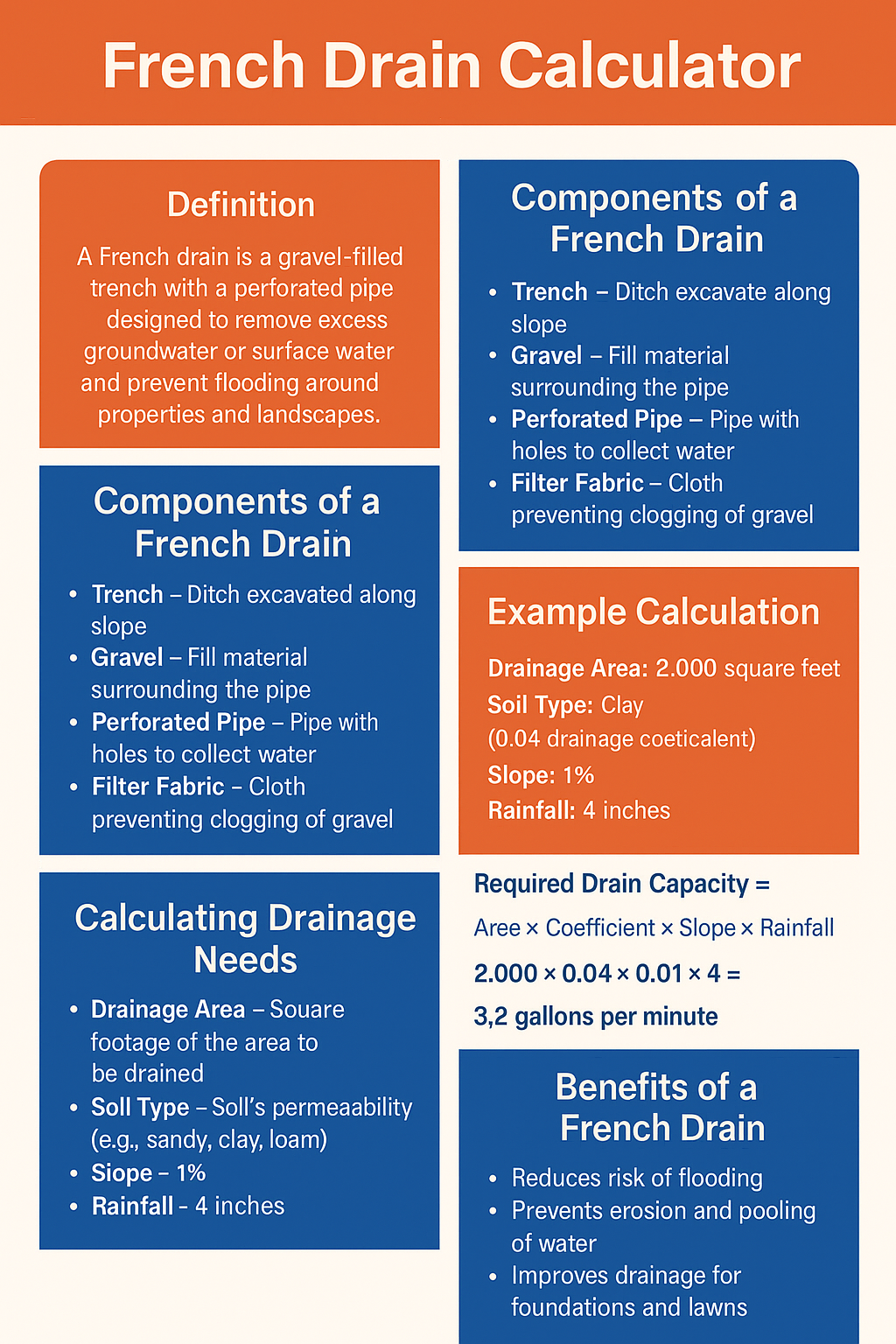Free French Drain Calculator Online
When it comes to managing yard flooding, soggy soil, or foundation water issues, a French drain is one of the most effective solutions. A French drain calculator helps determine the right size, depth, pipe length, and gravel volume needed for proper drainage. Tools like Construction Calculators ensure that whether you’re a DIY homeowner or a landscape contractor, you get the numbers right to build a system that works efficiently and lasts a long time.
French Drain Calculator
What Is a French Drain?
A French drain is a trench filled with gravel or rock that contains a perforated pipe to redirect surface water and groundwater away from an area. It works by collecting and channeling water through sloped piping into a discharge area like a ditch, dry well, or storm drain.
French drains are commonly used to:
- Prevent basement flooding
- Eliminate standing water in lawns
- Protect foundations
- Improve yard grading and drainage

Why Use a French Drain Calculator?
A French drain calculator ensures you use the right pipe size, trench dimensions, and materials for your drainage needs. It helps you:
- Calculate trench volume
- Estimate gravel and pipe length
- Determine slope for proper water flow
- Save money by avoiding over-purchasing
- Build a system that meets drainage codes
Basic Formula for French Drain Volume
To calculate the volume of a trench, use the following formula: $$Volume (ft3)=Length (ft)×Width (ft)×Depth (ft)\text{Volume (ft}^3) = \text{Length (ft)} \times \text{Width (ft)} \times \text{Depth (ft)}Volume (ft3)=Length (ft)×Width (ft)×Depth (ft)$$
Convert this to cubic yards for ordering gravel: $$Volume (yd3)=Volume (ft3)27\text{Volume (yd}^3) = \frac{\text{Volume (ft}^3)}{27}Volume (yd3)=27Volume (ft3)$$
Example: Gravel Volume Calculation
Let’s say you’re installing a French drain that’s:
- Length: 50 feet
- Width: 1.5 feet
- Depth: 1.5 feet
Step 1: $$Volume (ft3)=50×1.5×1.5=112.5 ft3\text{Volume (ft}^3) = 50 \times 1.5 \times 1.5 = 112.5\ \text{ft}^3Volume (ft3)=50×1.5×1.5=112.5 ft3$$
Step 2: $$Volume (yd3)=112.527≈4.17 yd3\text{Volume (yd}^3) = \frac{112.5}{27} \approx 4.17\ \text{yd}^3Volume (yd3)=27112.5≈4.17 yd3$$
Result: You’ll need about 4.17 cubic yards of gravel.
Pipe Slope Formula
French drains must have a slope to allow gravity to move water through the pipe. The ideal slope is 1% to 2%. $$Slope (%)=(Rise (ft)Run (ft))×100\text{Slope (\%)} = \left( \frac{\text{Rise (ft)}}{\text{Run (ft)}} \right) \times 100Slope (%)=(Run (ft)Rise (ft))×100$$
For example, if your trench is 50 feet long and you need a 1% slope: $$Rise=1100×50=0.5 ft\text{Rise} = \frac{1}{100} \times 50 = 0.5\ \text{ft}Rise=1001×50=0.5 ft$$
So, the pipe should drop 6 inches over 50 feet.
Key Inputs for the French Drain Calculator
Most calculators ask for:
- Trench length
- Trench width
- Trench depth
- Desired slope
- Pipe diameter
- Gravel type and density
The tool then gives you:
- Gravel volume (cubic feet or cubic yards)
- Pipe length needed
- Elevation change required for proper slope
Material Estimates
Gravel
The gravel layer should surround the pipe and extend several inches above and below. Pea gravel or angular stone is commonly used.
Perforated Pipe
4-inch perforated corrugated or PVC pipe is the standard. Larger areas may require 6-inch pipe.
Filter Fabric
Line the trench to prevent soil intrusion. This improves long-term performance.
Catch Basins or Inlets
Optional, but useful for directing surface water into the drain.
Common French Drain Sizes
| Application | Pipe Size | Trench Width | Gravel Needed |
|---|---|---|---|
| Yard Drainage | 4 in | 12–18 in | Moderate |
| Basement Waterproofing | 4–6 in | 12–24 in | High |
| Driveway Edges | 4 in | 8–12 in | Low to Moderate |
FAQs
Q1: What slope should a French drain have?
A minimum of 1% slope (1 foot of drop per 100 feet of length) is recommended.
Q2: How much gravel goes above the pipe?
Typically 3–4 inches. The pipe should sit at least 2 inches above the trench bottom with gravel fully surrounding it.
Q3: Can I install a French drain without fabric?
You can, but using filter fabric prevents sediment clogging and extends the life of the system.
Q4: Does the type of gravel matter?
Yes. Use washed gravel or crushed stone 0.5 to 1.5 inches in size. Avoid sand or fine particles.
Q5: Can I reuse existing trench for a second French drain?
Only if the trench meets proper width, depth, and slope requirements.
Final Thoughts
A well-designed French drain system starts with accurate measurements and calculations. A French drain calculator helps ensure you buy the right amount of gravel, install the correct length of pipe, and maintain the ideal slope for drainage. Whether you’re solving backyard flooding or protecting your foundation, this tool simplifies planning and execution. Support your project further with tools like the General Construction Calculators, Tank Volume Calculator, and Stair Calculator.
Remember the core formula: $$Volume (ft3)=Length×Width×Depth\text{Volume (ft}^3) = \text{Length} \times \text{Width} \times \text{Depth}Volume (ft3)=Length×Width×Depth Slope (%)=(RiseRun)×100\text{Slope (\%)} = \left( \frac{\text{Rise}}{\text{Run}} \right) \times 100Slope (%)=(RunRise)×100$$
Plan smart. Drain smarter. Let the water flow where it should away from your home.
